Beginning Greek Grammar Guide
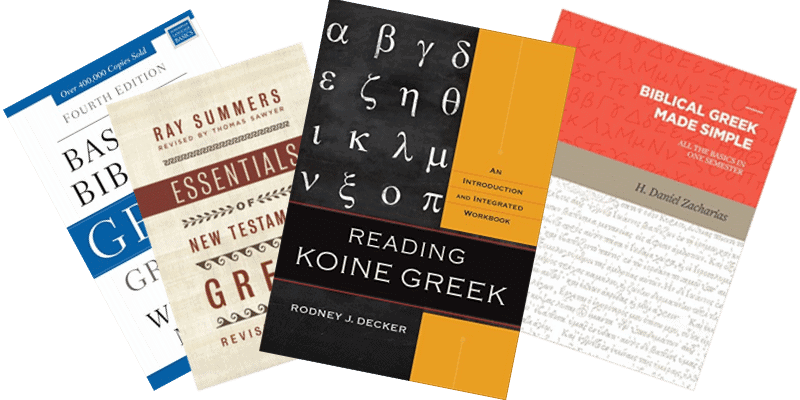
What's On This Page
Top 10 Countdown Video
Introduction
I regularly review beginning Greek Grammars on the Biblical Mastery Academy YouTube channel.
After I review each grammar, I assign it a spot on “the leaderboard” below. This page lists the grammars I’ve reviewed ranked in order.
For each grammar you’ll find:
- Publication information and purchase links
- Video review
- Use case
- Distinctives
- Strengths
- Weaknesses
If you have anything you’d like me to add to this list, let me know. Similarly, if you’d like me to add a specific grammar to this list, also, let me know. However, note that there are a lot of grammars on the market and more coming out every year, so I may not get to every grammar in a timely manner. I tend to prioritize more recent grammars over older ones.
To find out when new reviews are published, subscribe on YouTube.
1. Merkle and Plummer, Beginning with New Testament Greek
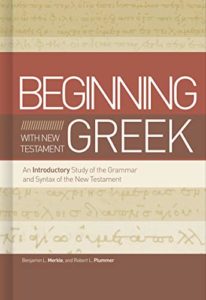
Benjamin L. Merkle and Robert L. Plummer, Beginning with New Testament Greek: An Introductory Study of the Grammar and Syntax of the New Testament (Nashville: B&H Academic, 2020), 281 pages
Video Review
Click the thumbnail to watch my review of this grammar.

Use Case
Best all-round grammar, ideal for self-study, but also great as a classroom grammar or to help refresh.
Distinctives
Strengths
- Strong morphology and guidance
- Streamlined approach
- Good treatment of liquid verbs
- Clear guidance for what to memorize
- Built in workbook with several types of exercises
- Lots of online resources available
Weaknesses
- Possibly introduces too many exegetical categories
- Minor: Holds to 3 aspect view of verbs
- Minor: Uses helper verbs for present tense form translation.
2. Harris, Introduction to Greek Grammar
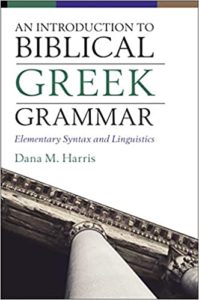
Dana Harris, An Introduction to Biblical Greek Grammar: Elementary Syntax and Linguistics (Grand Rapids: Zondervan Academic, 2020), 471 pages.
Video Review
Click the thumbnail to watch my review of this grammar.
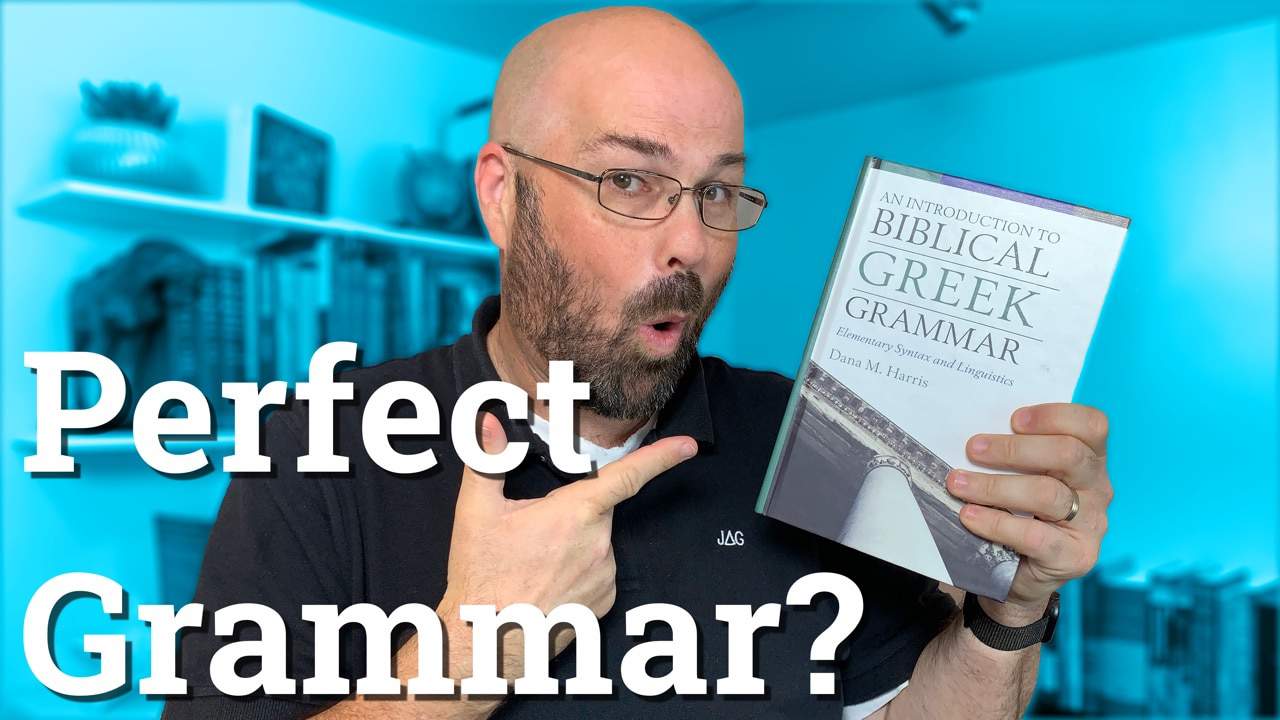
Use Case
Classroom grammar, reference grammar
Distinctives
Strengths
- Best in class discussion of morphology
- Excellent explanations of English grammar help with learning Greek
- Consolidated paradigms
- Clear guidance on what needs to be learned.
- Helpful summaries
- Revisits concepts expanding on them later
Weaknesses
- Some chapters are a little overwhelming for students
- Verbal aspect seems confused with aktionsart
- Doesn’t mention liquid aorists (but covers liquid futures well)
- Still refers to deponency
- Requires an additional purchase for exercises, making this an expensive option
3. Decker, Reading Koine Greek
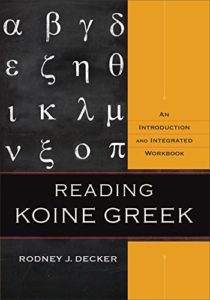
Rodney J. Decker, Reading Koine Greek: An Introduction and Integrated Workbook (Grand Rapids: Baker Academic, 2014), 564 pages
Video Review
Click the thumbnail to watch my review of this grammar.

Use Case
Great for self-study or classroom use. Also an ideal reference grammar or for reviving your Greek. Intended to be used into second year and exegesis classes.
Distinctives
Strengths
- Best in class treatment of verbs
- Up to date and linguistically based understanding of verbs
- Revisits concepts, building them out
- Excellent relation to English grammar
- Built in workbook with several types of exercises
- Provides larger vocabulary and utilizes broader texts in exercises
Weaknesses
- Minor: Holds to 3 aspect view of verbs
- Minor: Uses helper verbs for present tense form translation
- Content may be overwhelming for some first-time learners
Pair with Croy for simplified explanations or with Mounce’s Basics of Biblical Greek for more on morphology.
4. Dobson, Learn New Testament Greek
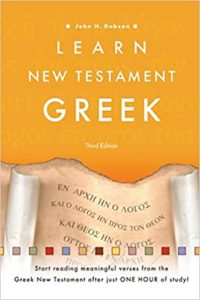
John H. Dobson, Learn New Testament Greek (Grand Rapids: Baker Academic, 2005), 333 pages.
Video Review
Click the thumbnail to watch my review of this grammar.

Use Case
Designed for and ideal for self-study.
Distinctives
Very different approach to learning the language, almost eliminating memory work and paradigms, delaying grammatical instruction until much later in the students study. Moves quickly and is intended to help keep students moving.
Strengths
- Focused on reading and reinforcement through repetition.
- Eliminates technical grammar discussion
- Minimal memory work
- Short, simple exercises
- Learn by doing
Weaknesses
- Weak indexing
- No discussion of verbal aspect, holds to time in the inidicative
- Minimal vocabulary or guidance for vocabulary acquisition
- Delayed grammar later may lose students prematurely
5. Mounce, Basics of Biblical Greek
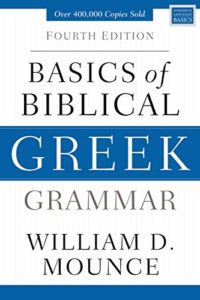
William D. Mounce, Basics of Biblical Greek (Grand Rapids: Zondervan Academic, 2019), 415 pages.
Video Review
Click the thumbnail to watch my review of this grammar.
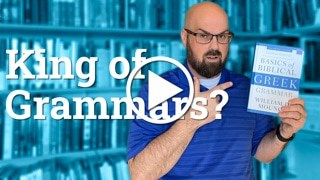
Use Case
Ideal as a classroom grammar, but great for reviving Greek or as a reference grammar.
Distinctives
Strengths
- Best in class discussion of morphology
- Excellent explanations of English grammar help with learning Greek
- Consolidated paradigms
- Clear guidance on what needs to be learned.
- Helpful summaries
- Revisits concepts expanding on them later
Weaknesses
- Some chapters are a little overwhelming for students
- Verbal aspect seems confused with aktionsart
- Could provide more coverage of liquid aorists (but covers liquid futures well)
- Still refers to deponency, even in the 4th edition
- Most expensive grammar (if you buy the workbook too)
6. Gibson and Campbell, Reading Biblical Greek
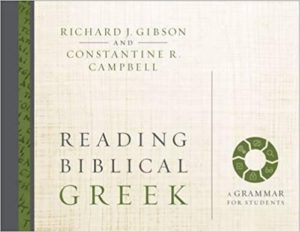
Richard J. Gibson and Constantine R. Campbell (Grand Rapids: Zondervan), 125 pages
You can also get the workbook from Amazon here.
Video Review
Click the button to watch my review of this grammar.
Use Case
Designed almost exclusively for classroom work.
Distinctives
Keeps concepts small, but depends on group interaction. Aspectually, this is very good, but not ideal for self-study.
Strengths
- Designed to have students work through the gospel of Mark with some fluency.
- Aspect is treated very well.
- Minimal memory work
- Short, simple exercises
- Learn by doing
Weaknesses
- Vocabulary is focused around the gospel of Mark so may skip words that occur regularly elsewhere.
- Depends on instructor, so requires preparation to teach through and could benefit from more guidance or a fuller teachers guide.
7. Zacharias, Biblical Greek Made Simple
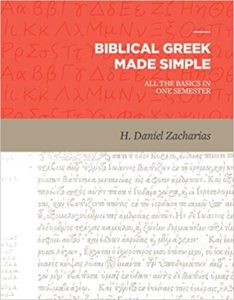
Danny Zacharias, Biblical Greek Made Simple (Bellingham, WA: Lexham Press, 2018), 284 pages
Video Review
Click the button to watch my review of this grammar.
Use Case
Classroom or self-study (see distinctives)
Distinctives
Strengths
- Very good descriptions and explanations
- Excellent formatting and use of color
- Helpful “The least you need to know” sections at the end of each chapter
- Fully embraces technology, and includes video links
- Learn Logos at the same time as Greek
Weaknesses
- Very dense information, and significant per-chapter homework requirements offset by “the least you need to know” sections for each chapter
- Could do with more interaction with how English works to clarify how Greek is similar or different
8. Croy, A Primer for Biblical Greek
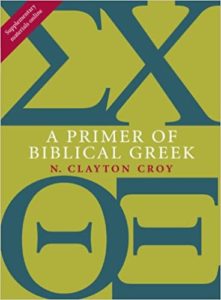
N. Clayton Croy, A Primer of Biblical Greek (Grand Rapids: Eerdmans, 1999), 203 pages.
Video Review
Click the button to watch my review of this grammar.
Use Case
Classroom grammar.
Distinctives
Strengths
- Very good descriptions and explanations
- Lots of exercises drawn from the NT and LXX as well as author-created
Weaknesses
- Dated – teaches deponency and largely doesn’t deal with verbal aspect at all
- No answer key for exercises
- Quirk: emphasizes inclusive language
9. Schwandt, An Introduction to Biblical Greek
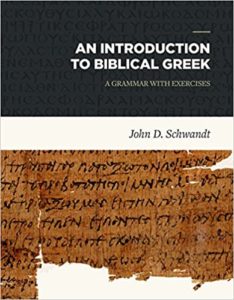
Danny Zacharias, Biblical Greek Made Simple (Bellingham, WA: Lexham Press, 2018), 284 pages
Video Review
Click the button to watch my review of this grammar.
Use Case
Reviving Greek or possibly solo learning.
Distinctives
Strengths
- Excellent discussion of morphology
- Excellent formatting and use of color
- Helpful “The least you need to know” sections at the end of each chapter
- Built in workbook with excellent variety of exercises to help students learn
- Includes answer key
- Difficult subjects are introduced gradually
Weaknesses
- Participles in one chapter may be a little brief for this difficult component of biblical Greek
- Holds to time in the indicative mood
- Light discussion of moods
- Treats cases in a different order to most grammars
10. Black, Learn to Read New Testament Greek
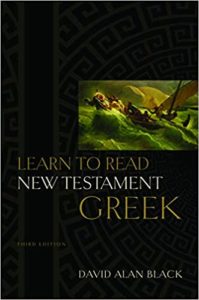
David Alan Black, Learn to Read New Testament Greek (Grand Rapids: Baker Academic, 2009), 215 pages.
Video Review
Click the button to watch my review of this grammar.
Use Case
Classroom grammar
Distinctives
Strengths
- Strong exercises including English to Greek
- Doesn’t focus on extraneous grammatical concepts
Weaknesses
- Dated: Teaches deponency
- Some chapters might be overwhelming to students
- Doesn’t provide enough guidance for what students should learn
11. Summers, Essentials of New Testament Greek, Revised Edition
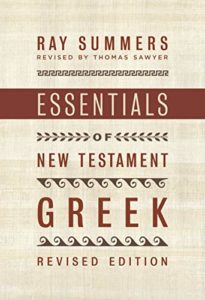
Ray Summers, Essentials of New Testament Greek, revised ed. (Nashville: B&H Academic, 2019), 156 pages.
Video Review
Click the button to watch my review of this grammar.
Use Case
Classroom Grammar
Distinctives
Strengths
- Clear Descriptions
- Short chapters
- Great approach to third declension
- Exercises at the end of each chapter (workbook included)
- Order of content leaves more difficult concepts until the end
Weaknesses
- No answer key and no additional content
- Syntactically dated (teaches 8 cases)
- Often over-emphasizes meaning over form

